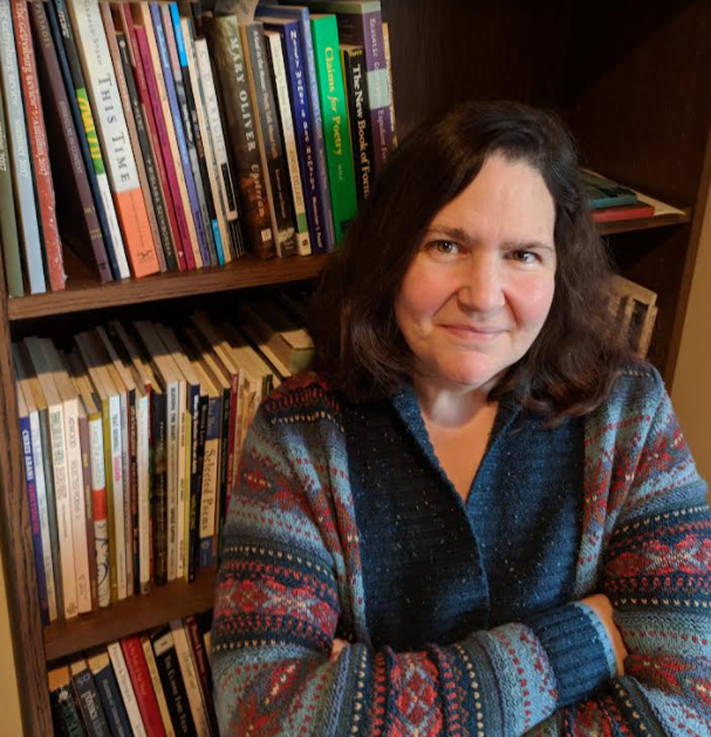|
The Breadcrumbs widget will appear here on the published site.
After reviewing Sally Rosen Kindred's latest book Where the Wolf, I was inspired to learn more about the poet behind such an impactful collection. Glittering with folklore and ancestral tales, I reached out to Kindred to ask more about her writing process, previous collections, and what it is like being an online poetry instructor. 1. Fairy tales and fabulism are prevalent in this collection. When did you first start telling stories using these elements?
Well, strictly speaking, I started doing it when I started telling stories. In fact, upstairs in my closet, there’s a ragged composition book from when I was eight, containing the first half of my first “novel,” which was called The Magical Flower Garden, and featured helpful and loquacious flora, so that gives you some idea! As for when it entered my poems…I think that while fabulism hovered over my earlier work—and crawled in often through figurative language—I was hampered, early on, by a mistaken sense that the fairy-tale, fantasy, and sci-fi impulses of my terrible, terrible fiction (which survives only in fanfic forums of the previous century) needed to be set apart from my poems, which could only get so speculative before I was breaking some important rules. However, by the time I started my second chapbook, Darling Hands, Darling Tongue—poems about the girls and women of Peter Pan—I’d renegotiated my relationship to these “rules,” which I’d realized were fairly patriarchal and also a bunch of nonsense. 2. Tell us about your other poetry collections. What was your process in putting all of your collections together? My process has varied. My first book, No Eden, was the result of years of writing whatever I could, and of realizing, along the way, that two different kinds of poems I was writing—poems about family, and poems about Noah and the Flood—were actually speaking to each other, and belonged in the same book. This observation led to new poems, which helped refine and braid the relationship between the themes. My second book, Book of Asters, came together in four years (fast, by my standards!). The process was focused, because I was driven by this obsession with using familia asteraceae (the aster family of flowers) to talk about family, infertility, adoption, young motherhood. But the poems are fueled by weirdness—there’s a sunflower Armageddon, there are Sirens. All that creepy energy moved it along. So did the routine of studying field guides for inspiration. Where the Wolf’s process was just an utter mess. It was going to be one kind of book—persona poems, considering women’s and girl’s experience (aging, the body, selfhood) through a fairy-tale lens—and then, just when I thought it was complete, I realized many poems weren’t doing that work, and they were doing something I didn’t yet understand. At that point, I spread all the pages out on the rug and walked through, picking up the poems from the original idea. They eventually became a chapbook (Says the Forest to the Girl, from Porkbelly Press). What remained on the rug, I worried, was just twenty-odd pages of leftovers…until I wrote what became the book’s first poem, “First Night.” In that poem, a ghost-wolf showed up. I let her in…and honestly, she’s how Where the Wolf got written—following that wolf around, into the next poem, and the next. 3.What are some of your recommendations for poetry collections or poets who have influenced your own work? There’s so much powerful poetry out there, it's hard to know where to start! For readers who are looking for recent work that engages with fabulism, fairy tale, and myth, I’d suggest Vievee Francis’s Forest Primeval, Sarah Kain Gutowski’s Fabulist Beast, Donika Kelly’s Bestiary, Kasey Jueds’s The Thicket, and really, any collection by Jennifer Givhan and Jeannine Hall Gailey. In terms of influence, again, it’s such a long list! It would certainly be incomplete without Lucille Clifton, Louise Glück, Larry Levis, Gerald Stern, Jack Gilbert, Joy Harjo, Anne Sexton, Sylvia Plath, Theodore Roethke, Elizabeth Bishop, H.D. And further back, Wordsworth and Dickinson. 4. You teach online workshops through Poetry Barn. What are some of the lessons you've learned by being a poetry instructor? I’ve learned so much from teaching poets! Of course, talking about a process (reading or writing poems) that I engage in intuitively forces me—in the best way—to think harder about what it all means—what the implications are for craft choices, what kinds of questions you can bring to decisions about syntax, sound, structure. And talking about a poem I love forces me to consider why I love it, why I’m reading and writing poems, what poetry can do that matters to me. But also, more importantly, the poets in my classes always show me possibilities—for form, music, and concept—I hadn’t considered. It’s easy for me to fall, without realizing it, into a particular set of moves (both readerly and writerly) determined by my own aesthetic. Reading widely helps challenge that, but engaging with poets in these classes throws all the doors open. The biggest lesson is being reminded of, and exposed to, so many other ways of seeing, approaching a poem. It’s what makes teaching such a thrill! Want to know more about Sally's work? Visit sallyrosenkindred.com.
0 Comments
CommentsYour comment will be posted after it is approved.
Leave a Reply. |
AuthorWrite something about yourself. No need to be fancy, just an overview. Archives
July 2024
Categories
All
|



 RSS Feed
RSS Feed






